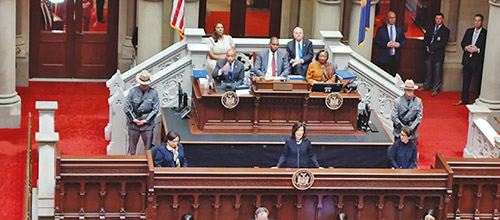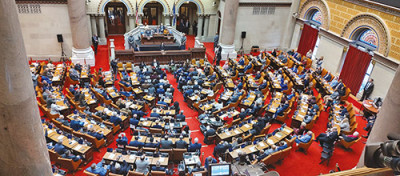
“After three very difficult, tragic and painful, years I’m proud to say that the State of our State is strong, but we have work to do,” said Governor Kathy Hochul declared last week in front of an audience of approximately 450 onlookers in the New York State Assembly chamber and even more online viewers. The governor, in a 45-minute speech, then unveiled portions of a 277-page State of the State message to the legislature titled “Achieving the New York Dream.” This piggybacked on last year’s message, “The New York Dream.”
Apparently achieving the New York dream is complicated and involves a complex amalgam of issues that are broken out into 14 issues and 147 policy proposals.
- A 16-point plan to build 800,000 new homes, including establishing a statewide database to promote transparency; legalization of basement apartments; and reclaiming vacant and abandoned homes.
“Housing, of course, is the big deal which it should be and I’m glad she’s focusing on it,” Assemblywoman Linda Rosenthal (D – Upper West Side, Manhattan) told The Jewish Link. “We have to ensure a lot of the housing that is built is truly affordable housing.”

“Overall, I think members who are concerned about their neighborhoods gentrifying just want to be comforted that real affordable housing is going to show up in their districts,” Assembly Speaker Carl Heastie (D – Bronx) said after the governor’s speech. “That’s where the members are focused. We want to put forward a plan that will address the housing crisis that we have here in the state of New York.”
- A 6-point plan to care for those afflicted by mental health including dramatically expanding outpatient services and creating 500 new housing units for such individuals.
“I’m proud to announce we will be investing more than $1 billion and making critical policy changes to finally and fully meet the mental health needs of our state,” Hochul said. “Right now, nearly 3,200 New Yorkers struggling with severe mental illness or addiction are living on the street and subways. At the same time, we have insufficient levels of inpatient psychiatric beds and outpatient services. We will add 1,000 inpatient psychiatric beds, funding 150 new beds in state facilities and bringing 850 psych beds in hospitals back on line. This is more than half of the beds we have lost since 2014 and they will serve more than 10,000 New Yorkers each year. These actions are overdue.”
Rosenthal is getting an early start addressing this issue. “I have a bill to provide school psychologists with licenses so they can practice outside of the school,” Rosenthal said. “That will help ease the burden of the shortage of mental health professionals.”
- A 12-point plan to keep New Yorkers safe, including doubling the investment in alternatives to incarceration, reducing gun violence and violent crime among individuals under parole supervision, countering cyber threats, and combating the flow of fentanyl into communities across the state.
“We’re going to focus on our children because too many schools provide no mental health support,” Hochul acknowledged. “Our children need preventive services now to stop them from needing intensive services in the future. We aim to reduce unmet mental health needs among children by at least half in the next five years. Whether we’re talking about a child with behavioral challenges, or an adult suffering from depression, no one should go without a screening or a doctor’s appointment or counseling. And cost should never be a barrier. That includes care for those suffering from addiction, especially those struggling with opioids. There are too many families, including my own, who have endured the pain of losing a loved one. That’s why we will do more, working with federal and local partners, to stop the flow of illicit drugs into our communities and address new deadly additives like xylazine. We’ll send resources to localities that are working to shut down fentanyl suppliers.”
At least one Republican senator liked parts of Hochul’s speech but not the part about curtailing drug overdoses.
“Her speech was more aspirational than specific,” Andrew Lanza, deputy minority leader and floor leader (R – Great Kills, Staten Island) told The Jewish Link. “I liked that she spoke about mental health with seriousness, which is a problem that has gone on unaddressed for too long. I’m waiting to see what this one party rule in New York is going to do about this fentanyl crisis, which has taken the lives of thousands of New Yorkers. It is beyond a crisis. It is a human tragedy. It is the result of bad policies in New York and other places in the country.”
When it comes to combating crime, Hochul also focused on bail reform.
“The size of someone’s bank account should not determine whether they sit in jail, or return home, before they have even been convicted of a crime,” Hochul said. “That was the goal of bail reform. It was a righteous one, and I stand by it. Bail reform is not the primary driver of a national crime wave created by a convergence of factors, including the pandemic. And third, that the bail reform law as written now leaves room for improvement. As leaders, we cannot ignore that, when we hear so often from New Yorkers that crime is their top concern. And so, to my partners in the legislature, let’s start with this shared understanding and have a thoughtful conversation during the budget process about improvements we can make to the law.”
Lanza said he wants more judicial discretion added to the bail reform policies.
“We have to get back to a system where we allow judges to do what we hire them to do, which is to use their experience and the knowledge of the law, their intelligence, and their common sense to take a look as to what is before them to determine whether or not somebody presents a risk of flight based on concrete evidence, people who have bench warrants, who are recidivists and whether or not they present a danger to their community,” Lanza concluded.
- A 19-point plan to build a health-care system for New York’s future, including reforming the traveling nurse agency staffing practices, expanding access to primary care and modernizing the health reporting systems.
“The surprising thing about Governor Hochul’s healthcare agenda is that she doesn’t seem to have one. Her speech said…nothing about the looming turmoil for Medicaid—including the loss of billions in federal aid and a deadline to prune a million or more recipients from the rolls,” said Bill Hammond, senior fellow for health policy with the Empire Center. “Indeed, her speech did not include the word ‘Medicaid,’ even though it’s one of two biggest items in the state budget and covers the medical bills of one in three New Yorkers. Also going completely unmentioned was what should be the state’s highest public health priority—repairing and improving the state’s public health defenses, which showed themselves to be woefully unprepared for the coronavirus pandemic.”
- A 9-point plan to safeguard the climate and environmental future, including meeting the goals with a “cap-and-invest” program, advancing transportation electrification leading to zero-emissions vehicles and deployment of EV charging stations, and reducing waste by investing in local recycling programs.
“The faster we wean ourselves off fossil fuels the better we are for it,” Heastie said. “One-hundred-year storms are happening every few months now.”
Lanza, a proponent of using natural gas, disagreed with Heastie and Hochul.
“New York does not have an energy policy,” Lanza said. “New York is heading toward a very big energy problem. It’s all well and good that she wants to talk about zero emissions and climate change, fine. Typical of my friends on the left and in the Democratic Party, her solution to all that is to make it more expensive for hardworking New Yorkers to heat their homes.
“We are on the verge of a catastrophe if you want to keep telling people that they can’t use clean burning natural gas to heat their homes, okay, fine, what is the replacement? From the Democrats’ side, there is no replacement. She just said we’re getting rid of it without saying what the replacement will be. She has no plan for replacing that energy that translates to keeping people warm and alive.”
At least one group disagreed with a portion of Hochul’s energy policy.
“Gov. Hochul also declared that no low-income New Yorker should pay more than six percent of their income on electricity. Though noble, unfortunately there is currently no estimate of what this will cost,” said James Hanley, a fellow who focuses on energy and the environment at the Empire Center, an Albany-based think tank. “As residents are forced into electrification and electric cars by her policies, the price tag will surely climb. New Yorkers who will have to pay for these expensive policies deserve upfront cost estimates before the bill comes due.”
The Empire Center fellow is suspicious about the impact the cap-and-invest program would have on New York’s budget.
“Most notable is the directive for DEC (Department of Environmental Conservation) and NYSERDA (New York State Energy Research and Development Authority) to craft a cap-and-invest program for greenhouse gas emissions. While economists support such programs as the least costly way of reducing emissions, it is questionable whether it can work at the state level without driving businesses out of state,” Hanley said. “Further, such a major economy shaping policy should be developed by the elected legislature, not backroom bureaucrats.”
- A 1-point plan tying the minimum wage to the cost of living.
“The fact that you want to really get out of this trying to fix the minimum wage every couple of years, that’s a solid approach,” Heastie said. “I don’t know where we start with the number but the fact that she wants to have this consistently adjusted to the CPI (Consumer Price Index) is great.”
- A 10-point plan to improve education, including continuing a major commitment to pre-K expansion, creating a high school to college workforce pipeline, and establishing a state matching fund program for endowment contributions.
- An 8-point plan to attract and grow businesses in New York state, including establishing a new state initiative to focus on supply chain resiliency, investment in cell and gene therapy, and improving the Excelsior Program to attract businesses and jobs to New York state.
- A 7-point plan to improve New York’s number one industry—agriculture—including creating a food supply workforce pipeline, providing grant funding to expand food access, and increasing food manufacturing.
- A 14-point plan for lifting up all New Yorkers, including protecting reproductive rights and access, implementing over-the-counter contraception access, expanding the FreshConnect program to fight food insecurity, and modernizing gender-based violence policies and procedures.
- An 8-point plan to build a strong and equitable child care system, including raising the eligibility level to the maximum allowed under federal law, establishing a workforce retention program, and creating a pilot program for a New York state employer-supported child-care program.
- An 11-point plan to prioritize transportation safety, equity and efficiency, including creating a secure future for the MTA, moving forward with the light rail option for the Interborough Express, allowing New York City to lower its speed limit, and attempting to take high risk drivers off the road.
- An 8-point plan to improve state government by providing a better customer experience that would include lowering call wait times and reducing business reliance on phone calls, and launching a “One ID for New York state” program to improve digital access and implement e-signature technology.
- An 11-point plan to improve state government agency operations, including rebuilding the public sector workforce, expanding access to paid parental leave, and streamlining the process for forming LLC, LLP and LP corporations.
Hochul will add numbers to these policy initiatives when she presents her state budget to the legislature later this month. The current state budget totals $220 billion.
By Marc Gronich









